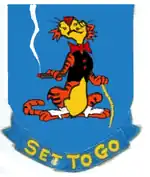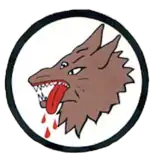| 454th Flying Training Squadron | |
|---|---|
 T-43 Gator Navigator trainier | |
| Active | 1942–1945; 1949–1951; 1955–1957; 1973–1993 |
| Country | |
| Branch | |
| Role | Navigator training |
| Motto(s) | Set to Go (after 1956) |
| Engagements | European Theater of Operations[1] |
| Decorations | Distinguished Unit Citation[1] |
| Insignia | |
| Patch with 454th Flying Training Squadron emblem |  |
| 454th Fighter-Bomber Squadron emblem[note 1][1] |  |
| 454th Bombardment Squadron emblem[2] |  |
| World War II fuselage code[2] | RJ |
The 454th Flying Training Squadron is an inactive United States Air Force unit. It was last assigned to the 323d Flying Training Wing at Mather Air Force Base, California, where it was inactivated on 1 October 1993.
History
World War II

Activated as a Martin B-26 Marauder medium bomber squadron; trained under Third Air Force in the southeastern United States. Deployed to European Theater of Operations ; assigned to VIII Bomber Command, 3d Bombardment Division in England. Engaged in combat operations over France and the Low Countries, attacking enemy military targets; formations; airfields; railroads; bridges and other raids to disrupt enemy defences. Coordinated raids with VIII Bomber Command heavy strategic bombardment of military and industrial targeted in Nazi Germany and in Occupied Europe by striking Luftwaffe day interceptor airfields to cause maximum disruption of air defenses when heavy bomber groups were returning from bombardment raids. Destroyed support buildings; barracks and enemy aircraft on the ground.
After D-Day invasion of Europe, engaged in tactical air support of Allied ground forces, carrying out bombardment attacks against enemy strong points, structures and targets of opportunity when making sweeps of enemy rear areas. Moved from England to Advanced Landing Grounds in France and further eastward as ground forces advanced across continent; engaging enemy targets during the Western Allied invasion of Germany in early 1945. Continued combat operations until German capitulation in May 1945.
Became part of the United States Air Forces in Europe forces in Occupied Germany; summer 1945. Demobilized in Germany in November and squadron inactivated as a paper unit in the United States.
Reserve operations
Reactivated as a Douglas B-26 Invader reserve light bomber squadron in 1947. Trained in the reserves; mobilized in 1951 due to the Korean War. Personnel and aircraft reassigned to other units and squadron inactivated.
Fighter-Bomber operations
Reactivated as the 454th Fighter-Bomber Squadron, a Tactical Air Command fighter squadron in 1955; inactivated in 1957 due to budget reductions.
Navigator training
Reactivated by Air Training Command as a navigator training squadron in 1972; inactivated with the closure of Mather Air Force Base and the inactivation of its host unit in 1993.
Lineage
- Constituted as the 454th Bombardment Squadron (Medium) on 19 June 1942
- Activated on 4 August 1942
- Redesignated 454th Bombardment Squadron, Medium c.20 August 1943
- Inactivated on 26 November 1945
- Redesignated 454th Bombardment Squadron, Light on 9 September 1947
- Activated in the reserve on 26 September 1947
- Ordered to active service 10 March 1951
- Inactivated on 17 March 1951.
- Redesignated 454th Fighter-Bomber Squadron on 9 May 1955
- Activated on 8 August 1955
- Inactivated on 1 September 1957[3]
- Redesignated 454th Flying Training Squadron and activated on 1 April 1973
- Inactivated on 1 October 1993
Assignments
- 323d Bombardment Group, 4 August 1942 – 26 November 1945
- 323d Bombardment Group, 26 September 1947 – 17 March 1951
- 323d Fighter-Bomber Group, 8 August 1955 – 1 September 1957[3]
- 323d Flying Training Wing, 1 April 1973 – 1 October 1993
Stations
|
|
Aircraft
- Martin B-26 Marauder, 1942–1945
- Douglas B-26 Invader, 1947–1951
- North American F-86 Sabre, 1955–1956
- North American F-100 Super Sabre, 1957-1957[3]
- Convair T-29 Flying Classroom 1973-1975
- Boeing T-43 1973-1993
References
Notes
- Explanatory notes
- Citations
- 1 2 3 Maurer, Combat Squadrons, pp.559-560
- 1 2 Watkins, pp.100-101
- 1 2 3 Lineage information through May 1963 in Maurer, Combat Squadrons, pp.559-560.
- ↑ Station number in Anderson, p. 20.
- ↑ Station number in Anderson, p. 25.
- ↑ Station number in Anderson, p. 28.
- ↑ Station number in Johnson, p. 15.
- ↑ Station number in Johnson, p. 17.
- ↑ Station number in Johnson, p. 20.
- ↑ Station number in Johnson, p. 22.
- ↑ Station number in Johnson, p. 40.
- ↑ Station number in Johnson, p. 49.
- ↑ Station information through May 1963 in Maurer, Combat Squadrons, pp.559-560, except as noted.
Bibliography
![]() This article incorporates public domain material from the Air Force Historical Research Agency
This article incorporates public domain material from the Air Force Historical Research Agency
- Maurer, Maurer, ed. (1983) [1961]. Air Force Combat Units of World War II (PDF) (reprint ed.). Washington, DC: Office of Air Force History. ISBN 0-912799-02-1. LCCN 61060979.
- Maurer, Maurer, ed. (1982) [1969]. Combat Squadrons of the Air Force, World War II (PDF) (reprint ed.). Washington, DC: Office of Air Force History. ISBN 0-405-12194-6. LCCN 70605402. OCLC 72556.
- Ravenstein, Charles A. (1984). Air Force Combat Wings, Lineage & Honors Histories 1947-1977 (PDF). Washington, DC: Office of Air Force History. ISBN 0-912799-12-9. Retrieved 17 December 2016.
- Watkins, Robert (2008). Battle Colors. Vol. III Insignia and Markings of the Ninth Air Force In World War II. Atglen, PA: Shiffer Publishing Ltd. ISBN 978-0-7643-2938-8.